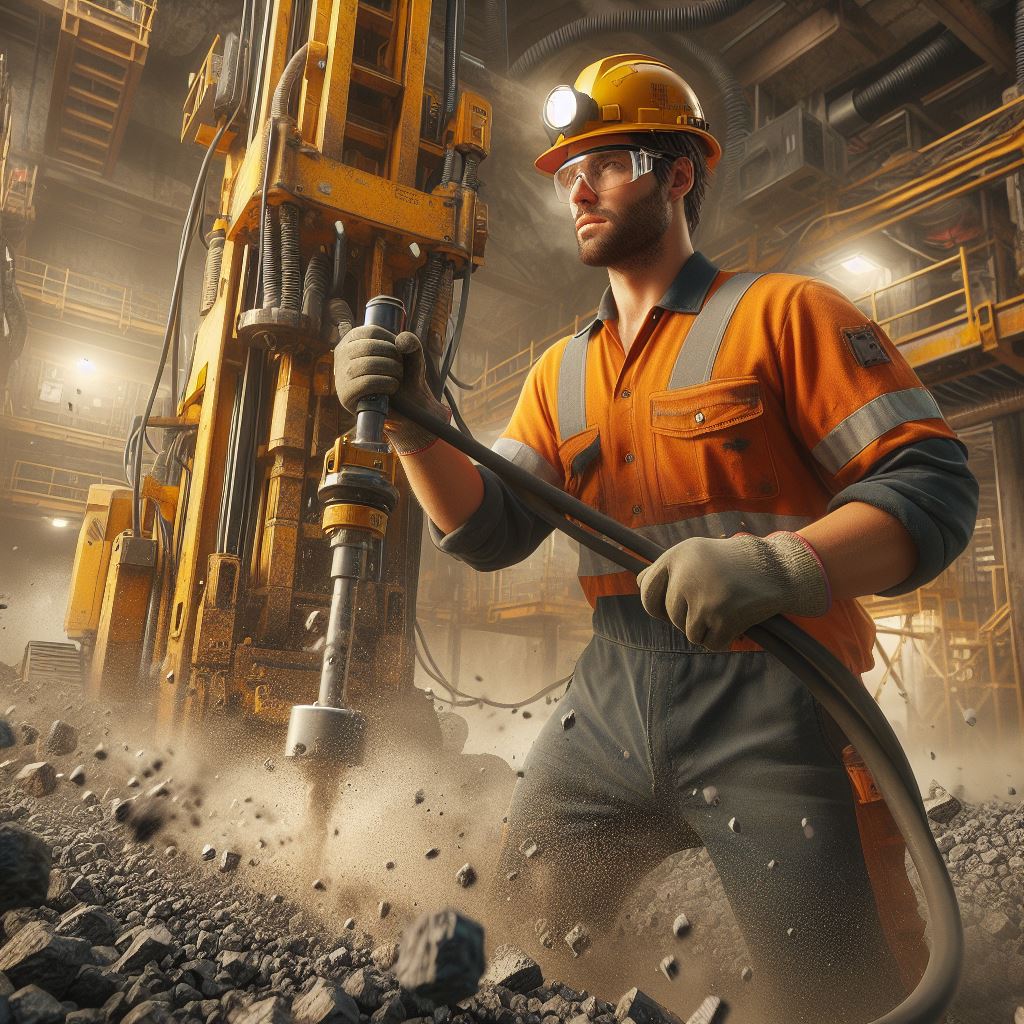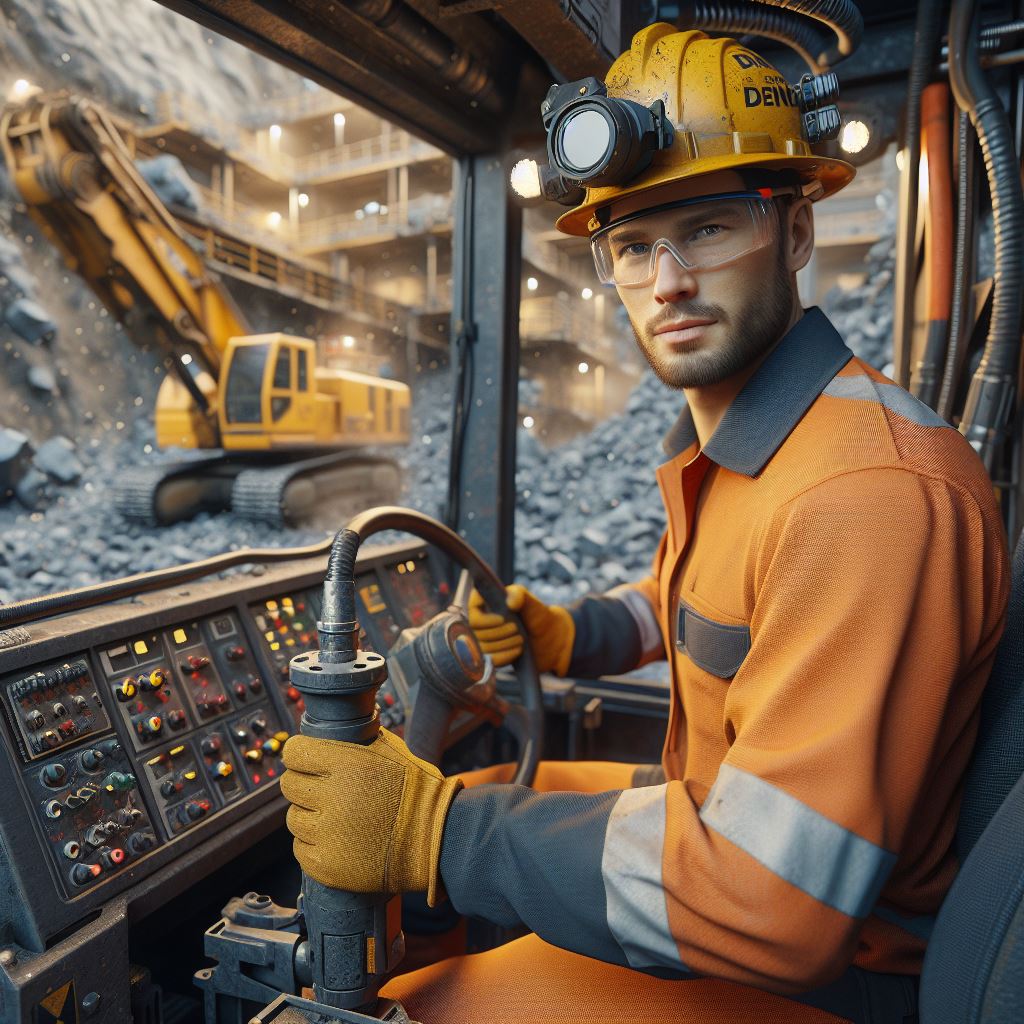Introduction
Importance of sustainability in the mining industry
The mining industry in Australia has been going through significant changes in recent years, with sustainability becoming a top priority.
As the industry relies heavily on the extraction and utilization of natural resources, it is essential to balance economic growth with the long-term well-being of our environment and society. This is where the role of engineers becomes crucial.
Engineers are at the forefront of developing and implementing sustainable mining practices. They are responsible for designing systems and processes that minimize the negative impact of mining activities on the environment.
This includes ensuring efficient use of resources, reducing waste and emissions, and finding alternative solutions for energy consumption.
Role of engineers in promoting sustainability
Furthermore, engineers play a crucial role in fostering community engagement and social responsibility within the mining sector.
They actively collaborate with local communities to identify and address their concerns, promote inclusive development, and contribute to the overall well-being of the communities affected by mining operations.
In promoting sustainability, engineers also focus on the rehabilitation and reclamation of mined land. They employ innovative techniques to restore ecosystems and create sustainable land use practices.
This involves not only restoring the physical landscape but also reviving biodiversity and supporting the local communities that depend on the land.
Overall, engineers are instrumental in driving sustainable development in the mining industry. Their expertise and commitment to finding solutions that balance economic growth, environmental preservation, and social well-being are crucial for the future of mining in Australia.
By actively embracing sustainability, engineers pave the way for a responsible and prosperous mining sector that benefits both present and future generations.
Overview of the Australian mining industry
Brief history and growth
The Australian mining industry has a long and rich history, beginning with the discovery of gold in 1851. It quickly boomed, attracting prospectors from around the world who hoped to strike it rich.
The industry’s growth continued over the years, expanding to include a wide range of minerals such as iron ore, coal, and copper.
Economic significance
The mining industry plays a crucial role in the Australian economy, contributing significantly to its growth and prosperity. It is one of the country’s largest export industries, generating substantial revenue and employment opportunities.
Australian mining companies have established a global reputation for their expertise, technological advancements, and commitment to sustainable practices.
Environmental impact
The Australian mining industry impacts the environment through soil erosion, habitat destruction, and pollution release.
Engineers implement sustainable practices, reduce waste, and promote environmental stewardship.
They develop innovative technologies to minimize mining’s environmental footprint, collaborating with other professionals.
Engineers focus on reducing water usage, managing wastewater, and employing advanced treatment technologies.
They improve energy efficiency by optimizing machinery, integrating renewables, and reducing greenhouse gas emissions.
Engineers prioritize worker safety through strict protocols, inspections, training, and safety equipment.
The industry’s economic significance is accompanied by environmental challenges.
Engineers mitigate these challenges with sustainability, innovation, and safety measures.
Their efforts ensure the industry thrives while minimizing environmental impact and safeguarding worker well-being.
Read: The Economics of Farming in Australia Unveiled
The role of engineers in the mining industry
Traditional responsibilities
Engineers have long played a crucial role in the mining industry, taking on various responsibilities.
- Designing and constructing efficient mining infrastructure to extract valuable resources.
- Ensuring the safety of workers through the implementation of proper engineering controls.
- Maintaining and repairing mining equipment to sustain operations and minimize downtime.
- Optimizing mining processes to increase productivity and maximize resource utilization.
- Managing environmental impacts by implementing proper waste disposal and pollution control measures.
These traditional responsibilities have formed the foundation of engineering in the mining sector.
Evolving role in promoting sustainability
Recently, the role of engineers in the mining industry has evolved to focus on promoting sustainability.
Designing and implementing sustainable mining practices
Engineers are now tasked with designing mining processes that minimize environmental degradation, reduce water usage, and mitigate biodiversity loss.
Developing and utilizing eco-friendly technologies
Engineers are at the forefront of developing and implementing new technologies that help reduce the industry’s ecological footprint.
Improving energy efficiency and reducing carbon emissions
Engineers are finding innovative ways to optimize energy usage, such as using renewable energy sources and improving energy storage systems.
Your Personalized Career Strategy
Unlock your potential with tailored career consulting. Get clear, actionable steps designed for your success. Start now!
Get StartedThese emerging responsibilities demonstrate engineers’ commitment to sustainable mining practices.
By actively incorporating sustainability into their work, engineers contribute to the industry’s long-term viability and success.
For example, designing and implementing sustainable mining practices not only reduce environmental impacts but also improve the industry’s social license to operate.
Engineers who develop and utilize eco-friendly technologies help to minimize the release of harmful substances into the environment, protecting ecosystems and local communities.
Additionally, improvements in energy efficiency and the reduction of carbon emissions enhance the industry’s contribution to fighting climate change.
Engineers are instrumental in finding solutions to lessen the environmental impact of mining operations and promote responsible resource extraction.
These advancements are essential for the mining industry to maintain its social license to operate in an increasingly environmentally conscious world.
Moreover, the evolving role of engineers in the mining industry also presents new opportunities for professional growth and innovation.
Engineers now have the chance to pioneer technologies and practices that can revolutionize the way mining operates, making it more sustainable and environmentally friendly.
Sustainability is no longer a peripheral concern but a central focus for engineers in mining.
Generally, engineers in the mining industry have traditionally had important responsibilities in designing, maintaining, and optimizing mining operations.
However, their role has evolved to encompass a greater focus on promoting sustainability through sustainable mining practices, eco-friendly technologies, and energy efficiency.
By actively incorporating sustainability into their work, engineers contribute to the industry’s long-term viability, environmental protection, and social acceptance.
With their expertise and innovation, engineers pave the way for a more sustainable future in the mining industry.
Stand Out with a Resume That Gets Results
Your career is worth more than a generic template. Let us craft a resume and cover letter that showcase your unique strengths and help you secure that dream job.
Get HiredRead: Exploring Permaculture Practices in Australia
Sustainable practices in Australian mining
Adoption of renewable energy sources
The mining industry in Australia is increasingly recognizing the importance of incorporating renewable energy sources into its operations. By reducing reliance on non-renewable sources such as fossil fuels, mining companies can contribute to a more sustainable future.
One way that Australian mining engineers are embracing renewable energy is through the installation of solar panels. These panels harness the power of the sun, providing a clean and reliable source of energy for mining sites.
By utilizing solar energy, mining operations can reduce their carbon footprint and decrease their dependence on traditional energy sources.
Additionally, wind power is another renewable energy source being adopted by the mining sector. With Australia’s vast open spaces and strong winds, wind farms are becoming more prevalent.
By harnessing the power of wind, mining companies can generate electricity to meet their operational needs while minimizing their environmental impact.
Water management and conservation
Water is a precious resource, particularly in arid regions like Australia. Mining engineers play a crucial role in ensuring responsible water management and conservation practices.
One approach to water management is the implementation of water recycling systems. Through advanced filtration and treatment processes, mining companies can recycle and reuse water, reducing the strain on local water supplies.
This not only helps preserve precious water resources but also minimizes the impact on surrounding ecosystems.
Furthermore, mining engineers employ innovative methods like water harvesting and storage to capture and store rainwater. These measures ensure that mining operations have access to water during dry periods while reducing the demand on local water sources.
Waste management and recycling
The mining industry produces a significant amount of waste, including tailings, waste rock, and other byproducts. Australian mining engineers are actively involved in developing sustainable waste management and recycling strategies.
One approach is to implement waste reduction initiatives at the design stage of mining projects. By minimizing waste generation through efficient planning and engineering, the amount of waste requiring disposal can be significantly reduced.
Mining engineers also work to improve waste disposal methods, such as using geotextile liners and containment systems to prevent contamination of surrounding soil and water resources.
Additionally, innovative techniques like reprocessing and repurposing of waste materials are being explored to minimize waste sent to landfills.
Biodiversity conservation and land rehabilitation
Mining operations often disrupt natural habitats and ecosystems. However, Australian mining engineers are committed to minimizing biodiversity loss and rehabilitating land after mining activities have ceased.
To conserve biodiversity, engineers collaborate with environmental experts to identify areas of ecological importance before any mining takes place. They develop strategies to protect these areas and relocate any endangered species, ensuring their survival.
Moreover, land rehabilitation is a critical aspect of sustainable mining practices. Engineers design and implement reclamation plans that aim to restore the landscape and ecosystem functionality.
Through initiatives like soil stabilization, re-vegetation, and re-introduction of native species, mining sites can be transformed into thriving ecosystems once mining activities cease.
Essentially, sustainable practices in Australian mining are essential for minimizing environmental impact and ensuring a positive legacy for future generations.
The adoption of renewable energy, responsible water management, waste recycling, and biodiversity conservation are all critical aspects that mining engineers are actively pursuing.
Through their dedication to sustainability, Australian mining engineers play a pivotal role in shaping a greener and more environmentally conscious mining industry.
Transform Your LinkedIn for Maximum Impact
Elevate your professional brand with a LinkedIn profile that attracts recruiters, showcases your expertise, and maximizes opportunities. Stand out in your industry with a profile built for success.
Boost ProfileRead: Soil Health and Its Importance in Aussie Farms

Case Studies of Successful Sustainability Initiatives
Rio Tinto’s Pilbara Iron Ore Operations
Rio Tinto, one of the largest mining companies in Australia, has made significant strides in incorporating sustainability into their operations in the Pilbara region. Through various initiatives, Rio Tinto has showcased their commitment to environmental stewardship and social responsibility.
One notable sustainability initiative undertaken by Rio Tinto is the use of autonomous trucks in their mining operations.
By replacing traditional truck drivers with automated systems, Rio Tinto has not only improved safety by reducing the risk of accidents but has also minimized fuel consumption and emissions.
This innovative approach has not only increased operational efficiency but has also reduced the impact on the environment.
Rio Tinto has also invested in energy-efficient technologies such as solar power. The company has installed a solar photovoltaic project at its West Angelas mine, which has reduced the use of diesel generators and decreased greenhouse gas emissions.
This project demonstrates Rio Tinto’s commitment to transitioning towards cleaner and renewable energy sources.
Additionally, Rio Tinto actively engages with local communities to ensure the sustainability of their operations.
The company has implemented various programs aimed at supporting the local economy, providing employment opportunities, and promoting the well-being of indigenous communities.
By collaborating with stakeholders and respecting the cultural heritage of the region, Rio Tinto has effectively fostered sustainable development.
BHP’s Olympic Dam Mine
BHP, another major player in the Australian mining industry, has embraced sustainability practices at its Olympic Dam mine. Through their innovative approaches, BHP has successfully integrated environmental management and community engagement into their operations.
One of the sustainability initiatives implemented by BHP is the optimization of water use. The Olympic Dam mine utilizes innovative technologies to minimize water consumption and maximize efficiency.
By implementing water recycling systems and advanced water management strategies, BHP has significantly reduced the mine’s water footprint and ensured the long-term sustainability of the local water resources.
BHP has also prioritized biodiversity conservation in their operations. The company has established partnerships with conservation organizations and implemented programs to protect and restore habitats affected by mining activities.
By actively rehabilitating disturbed areas and promoting biodiversity, BHP has shown its commitment to minimizing the ecological impact of its operations.
Furthermore, BHP actively engages with local communities through various initiatives. The company supports local businesses, provides employment opportunities, and invests in community infrastructure projects.
By fostering strong relationships with the communities surrounding the Olympic Dam mine, BHP has contributed to the social well-being and economic development of the region.
Fortescue Metals Group’s Renewable Energy Projects
Fortescue Metals Group (FMG) has demonstrated its commitment to sustainability through its renewable energy projects. By embracing clean energy solutions, FMG has made significant progress in reducing its carbon footprint and minimizing its environmental impact.
One of FMG’s notable renewable energy initiatives is the construction of the Fortescue River Gas Pipeline. This pipeline plays a crucial role in delivering natural gas to the company’s operations, reducing the reliance on diesel fuel.
By transitioning to natural gas, FMG has significantly reduced its greenhouse gas emissions and improved air quality in the region.
Another renewable energy project undertaken by FMG is the development of solar power plants. The company has invested in large-scale solar farms to generate clean and sustainable energy.
By harnessing the abundant sunlight in Western Australia, FMG has reduced its reliance on fossil fuels and paved the way for a more sustainable future.
Additionally, FMG actively collaborates with local communities and indigenous stakeholders. The company works closely with indigenous partners to promote cultural heritage preservation and economic empowerment.
Through its engagement initiatives, FMG ensures that the benefits of its operations are shared equitably and sustainably.
Essence, these case studies of successful sustainability initiatives in the Australian mining industry demonstrate that mining companies can effectively integrate environmental stewardship, social responsibility, and economic viability.
Through innovation, collaboration, and a proactive approach, companies like Rio Tinto, BHP, and Fortescue Metals Group are setting positive examples for sustainable mining practices.
By prioritizing the well-being of the environment and local communities, these companies are not only safeguarding the future but also creating a meaningful legacy for generations to come.
Read: Australian Cattle Farming: Methods and Myths
You Might Also Like: Australian Foresters & Indigenous Plants
Delve into the Subject: Aussie Agri Robots: Future Farms
Challenges and Opportunities for Engineers in Promoting Sustainability
Limited Awareness and Understanding of Sustainable Practices
Engineers face the challenge of combating the limited awareness and understanding of sustainable practices in the mining industry. They must actively promote the importance of sustainable mining through education and awareness campaigns.
Incorporating Sustainability into the Mining Life Cycle
Engineers have the opportunity to incorporate sustainability into every stage of the mining life cycle. From exploration to closure, they can design and implement environmentally friendly practices, such as minimizing waste and reducing energy consumption.
Collaborating with Stakeholders to Drive Change
Engineers need to collaborate with stakeholders, including governments, local communities, and industry organizations, to drive sustainable change in the mining sector. By engaging in dialogue and partnerships, engineers can develop innovative solutions that align with the needs and expectations of various stakeholders.
Leveraging Technological Advancements for Sustainable Mining
Advancements in technology provide engineers with opportunities to adopt sustainable mining practices. They can leverage automation, data analytics, and AI to improve efficiency, reduce environmental impact, and enhance worker safety.
Addressing Water Management Challenges
Engineers face the challenge of addressing water management issues in the mining industry. They must develop and implement sustainable water management strategies, such as recycling and treating mine water, to minimize water usage and prevent pollution.
Ensuring Responsible Mine Rehabilitation
Engineers play a crucial role in ensuring responsible mine rehabilitation. They must design and implement rehabilitation plans that restore the land affected by mining activities, promote biodiversity, and create sustainable post-mining land uses.
Overcoming Financial Constraints
Engineers often face financial constraints when promoting sustainable practices in the mining industry. They need to find innovative ways to overcome these constraints and demonstrate the long-term economic benefits of sustainable mining to gain support from investors and industry stakeholders.
Navigating Regulatory Frameworks and Standards
Engineers must navigate complex regulatory frameworks and standards related to sustainability in mining. They need to stay updated with the latest regulations and ensure compliance while also advocating for progressive changes that align with sustainable mining practices.
Fostering a Culture of Innovation and Continuous Improvement
Engineers have the opportunity to foster a culture of innovation and continuous improvement in the mining industry. They can encourage the adoption of new technologies, promote research and development, and drive industry-wide initiatives for sustainable mining.
Balancing Economic Growth and Environmental Concerns
Engineers face the challenge of balancing the need for economic growth with environmental concerns. They must strive for sustainable development that ensures long-term profitability while minimizing the impact on ecosystems and communities.
Ultimately, engineers in the mining industry face various challenges and opportunities in promoting sustainability.
By increasing awareness, incorporating sustainability into the mining life cycle, collaborating with stakeholders, leveraging technological advancements, and addressing specific issues, engineers can drive positive change and contribute to a more sustainable mining sector.
Conclusion
Recap of engineers’ sustainability role in Australian mining
Throughout this blog section, we have explored the significant role that engineers play in promoting sustainability in the Australian mining industry.
Their expertise and innovation have led to the development of technologies and practices that minimize environmental impact and protect natural resources.
By implementing solutions such as renewable energy systems and efficient waste management, engineers have successfully addressed the challenges faced by the industry.
Importance of continuing efforts to promote sustainable practices in the industry
It is crucial that we continue to prioritize and invest in sustainable practices in the mining sector. The long-term viability of the industry relies on minimizing its ecological footprint and ensuring the responsible use of resources.
By embracing sustainable technologies, engineers can drive positive change, reducing greenhouse gas emissions, conserving water, and mitigating the impact on local ecosystems.
Call to action for engineers to Embrace sustainability in mining
To achieve a truly sustainable mining industry, it is essential for engineers to wholeheartedly embrace sustainability principles in their work.
Engineers must consistently seek innovative solutions, implement best practices, and collaborate with stakeholders to improve environmental outcomes. By prioritizing sustainability, engineers can contribute to the industry’s growth while safeguarding the future for generations to come.
Lastly, engineers play a crucial role in promoting sustainability in Australian mining. Their efforts have been instrumental in reducing the industry’s environmental impact and ensuring the responsible use of resources.
However, the journey toward a more sustainable mining sector is far from over. The industry must continue to support and empower engineers to drive further advancements in sustainable practices.
Together, we can create a mining industry that flourishes while also protecting the environment.




